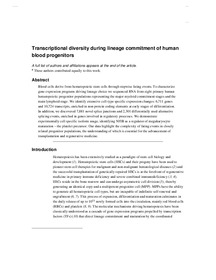Benvinguts al Repositori Digital de la UPF
Transcriptional diversity during lineage commitment of human blood progenitors
JavaScript is disabled for your browser. Some features of this site may not work without it.
Mostra el registre parcial de l'element
| dc.contributor.author | Chen, Lu |
| dc.contributor.author | Breschi, Alessandra, 1988- |
| dc.contributor.author | Guigó Serra, Roderic |
| dc.contributor.author | Palumbo, Emilio |
| dc.contributor.author | Rendon, Augusto |
| dc.date.accessioned | 2019-06-20T09:34:51Z |
| dc.date.available | 2019-06-20T09:34:51Z |
| dc.date.issued | 2014 |
| dc.identifier.citation | Chen L, Kostadima M, Martens JHA, Canu G, Garcia SP, Turro E et al. Transcriptional diversity during lineage commitment of human blood progenitors. Science. 2014 Sep 26;345(6204):1251033. DOI: 10.1126/science.1251033 |
| dc.identifier.issn | 1095-9203 |
| dc.identifier.uri | http://hdl.handle.net/10230/41853 |
| dc.description.abstract | Blood cells derive from hematopoietic stem cells through stepwise fating events. To characterize gene expression programs driving lineage choice, we sequenced RNA from eight primary human hematopoietic progenitor populations representing the major myeloid commitment stages and the main lymphoid stage. We identified extensive cell type-specific expression changes: 6711 genes and 10,724 transcripts, enriched in non-protein-coding elements at early stages of differentiation. In addition, we found 7881 novel splice junctions and 2301 differentially used alternative splicing events, enriched in genes involved in regulatory processes. We demonstrated experimentally cell-specific isoform usage, identifying nuclear factor I/B (NFIB) as a regulator of megakaryocyte maturation-the platelet precursor. Our data highlight the complexity of fating events in closely related progenitor populations, the understanding of which is essential for the advancement of transplantation and regenerative medicine. |
| dc.description.sponsorship | The work described in this manuscript was primarily supported by the European Commission Seventh Framework Program through the BLUEPRINT grant with code HEALTH-F5-2011-282510 (DH, FB, GC, JHAM, KD, LC, MF, SC, SF and SPG). Research in the Ouwehand laboratory is further supported by program grants from the National Institute for Health Research (NIHR, http://www.nihr.ac.uk; to AA, MK, PP, SBGJ, SN, and WHO); and the British Heart Foundation under numbers RP-PG-0310-1002 and RG/09/12/28096 (http://www.bhf.org.uk; to AR and WJA). KF and MK were supported by Marie Curie funding from the NETSIM FP7 program funded by the European Commission. The Cambridge BioResource (http://www.cambridgebioresource.org.uk), the Cell Phenotyping Hub, and the Cambridge Translational GenOmics laboratory (http://www.catgo.org.uk) are supported by an NIHR grant to the Cambridge NIHR Biomedical Research Centre (BRC). Research in the Soranzo laboratory (LV, NS and SW) is further supported by the Wellcome Trust (Grant Codes WT098051 and WT091310) and the EU FP7 EPIGENESYS initiative (Grant Code 257082). Research in the Cvejic laboratory (AC and CL) is funded by the Cancer Research UK under grant number C45041/A14953. SJS is funded by NIHR. MEF is supported by a British Heart Foundation Clinical Research Training Fellowship, number FS/12/27/29405. EBM is supported by a Wellcome Trust grant, number 084183/Z/07/Z. FAC, CL and SW are supported by MRC Clinical Training Fellowships and TB by a British Society of Haematology/NHS Blood and Transplant grant. RJR is a Principal Research Fellow of the Wellcome Trust, grant No. 082961/Z/07/Z. Research in the Flicek laboratory is also supported by the Wellcome Trust (grant number 095908) and EMBL. Research in the Bertone laboratory is supported by EMBL. KF and CvG are supported by FWO-Vlaanderen through grant G.0B17.13N |
| dc.format.mimetype | application/pdf |
| dc.language.iso | eng |
| dc.publisher | American Association for the Advancement of Science (AAAS) |
| dc.relation.ispartof | Science. 2014 Sep 26;345(6204):1251033 |
| dc.rights | This is the author’s version of the work. It is posted here by permission of the AAAS for personal use, not for redistribution. The definitive version was published in Science on vol. 345, num. 6204, 2014. DOI: 10.1126/science.1251033 |
| dc.subject.other | Empalmament alternatiu |
| dc.subject.other | llinatge cel·lular |
| dc.subject.other | Hematopoesi |
| dc.subject.other | Cèl·lules mare hematopoètiques |
| dc.title | Transcriptional diversity during lineage commitment of human blood progenitors |
| dc.type | info:eu-repo/semantics/article |
| dc.identifier.doi | http://dx.doi.org/10.1126/science.1251033 |
| dc.relation.projectID | info:eu-repo/grantAgreement/EC/FP7/282510 |
| dc.relation.projectID | info:eu-repo/grantAgreement/EC/FP7/215820 |
| dc.relation.projectID | info:eu-repo/grantAgreement/EC/FP7/257082 |
| dc.rights.accessRights | info:eu-repo/semantics/openAccess |
| dc.type.version | info:eu-repo/semantics/acceptedVersion |


